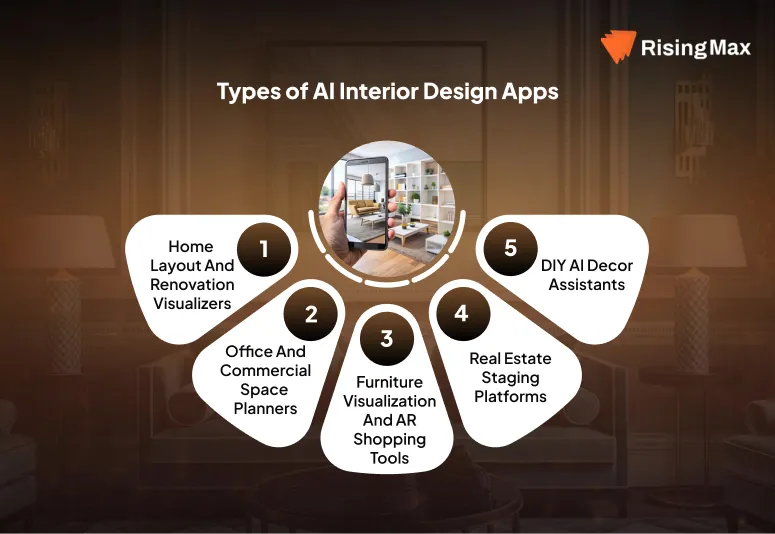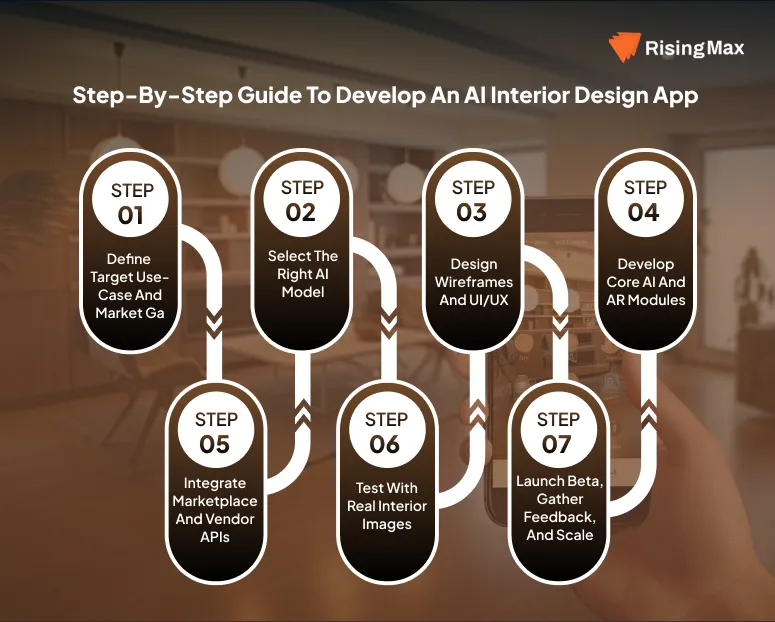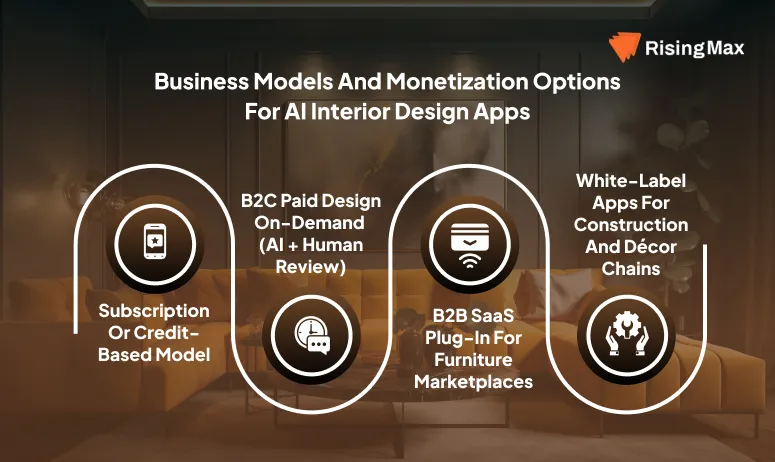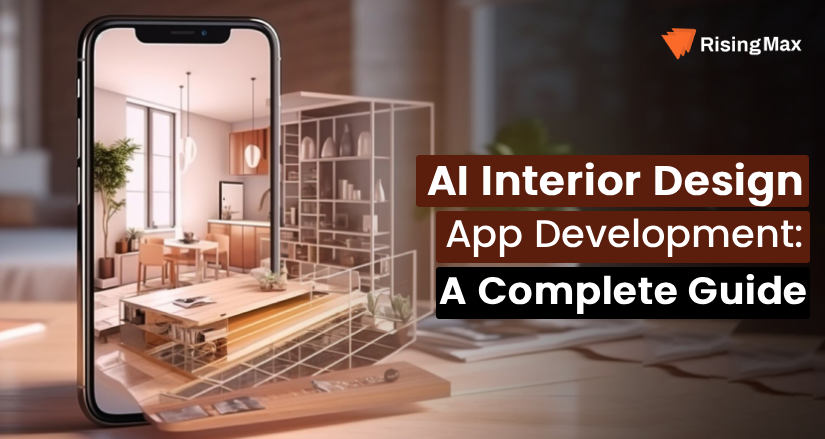Key Takeaways
- Over 78% of global interior design firms are integrating AI tools by 2025, marking the industry’s shift toward fully data-driven creativity.
- AI interior design apps turn weeks of work into minutes by automating layouts, renders, and style variations.
- Real business gains include lower staging costs, higher conversions for retailers, and faster client sign-offs for architects.
- Key technologies used are computer vision, generative and diffusion models, plus AR/VR and LiDAR for accurate visualization.
- Development cost depends on AI model complexity, AR/VR integration, platform scope, user roles, and regional rates.
The interior design industry will turn into its most data-driven phase ever. More than 78% of the firms from all over the world in this business integrate the latest AI tools into their work, transforming how spaces are planned and visualized in the year 2025. What took an interior design team weeks to create mood boards, layouts, and client revisions can now be automated via an AI interior design app in minutes.
AI is not displacing designers; it’s amplifying precision, personalization, and speed of projects. Modern AI interior design apps scan a room, detect its layout, materials, and lighting, then generate several design variations with the use of machine learning and generative AI. Each output would be measurable, adaptable, and custom-fit, merging aesthetics with analytics.
For businesses, this now directly translates to value: real-estate agencies are saving 40% on staging costs, furniture retailers showcase products in virtual environments, and architecture firms are utilizing AI for the immediate simulation of client-ready 3D renders. These aren’t PoCs; these are results that reshape a $5,373.8 million global interior design market.
In this 2025-2026 Guide to AI interior design app development, we will discuss the current market scenarios, technologies that are utilized, costs, and more. So, if you are a startup that wants to develop an AI interior design app, then this guide will outline everything.
Market Overview: How AI is Powering the Next Generation of Interior Designing Apps
The field of interior design is passing through one of its most dynamic transformations, powered by AI and immersive technologies. Evidence for this can be clearly seen in the fact that from 2025 to 2032, the global AI interior design market is anticipated to reach $6.96 billion at a CAGR of 21.51%, signaling a big shift toward data-led creativity and automation.
Here’s how the landscape is evolving:
- Data-Driven Design Boom: Interior design now relies not on intuition alone but is dictated by AI-led spatial data analysis, color psychology, and user preference analyses that recommend the best layouts and styles. Bringing analytics into creativity.
- The rapid adoption of AI + AR platforms is transforming interior design services worldwide.
- Features like drag-and-drop AI-powered room creation reduce design time by more than 60%.
- Leveraging generative AI, platforms generate real and multi-style room renders in seconds.
- Predictive AI models simulate lighting, materials, and energy efficiency in architectural firms before construction.
- Enterprise-Scale Adoption: Since 2023, enterprise adoption of AI-based design systems has increased by nearly 2X, with businesses using AI for:
-
- Faster project turnaround
- Data-driven personalization
- Better visualization and customer satisfaction
Are you looking to integrate AR/VR in interior designing and develop an AI tool to simplify your clients’ needs? Then connect with us to kickstart your AI interior design app development journey.
What is AI Interior Design App Development?
AI interior design app development involves developing intelligent solutions that change the way people design and perceive interior space. These interior design apps, with the help of AI, make the process faster. Moreover, it helps users to explore various layouts and ideas without the need to invest too much time in manual effort.
How AI Interior Design Apps Work
The working of an AI interior design app involves a transformation of a simple picture into a complete room design using computer vision, machine learning, and augmented reality. The process generally consists of a few steps:
- Image Upload: The user initiates this by uploading a photo or 3D scan of a room.
- Room Segmentation: The AI detects walls, floors, windows, and existing furniture to understand the structure of the space.
- AI Layout Rendering: The app automatically generates a layout that optimizes furniture placement, spacing, and flow.
- Decor Suggestion: Based on the users’ preferred style, the system suggests color palettes, lighting, and decor options.
- AR Preview: Using augmented reality, one can even see the final look of the space to be redesigned in real time before really changing anything.
Next, let’s explore how AI design automation differs from traditional interior design.
AI Design Automation vs Traditional Interior Designing: Key Differences
Here are the main differences between AI design automation and traditional interior design.
| Aspect | AI Design Automation | Traditional Interior Designing |
| Speed | Delivers full design concepts in minutes using automation | Takes days or weeks due to manual work |
| Personalization | Uses AI to tailor designs based on user data & style preferences | Depends on the designer’s subjective interpretation |
| Visualization | Offers real-time 3D & AR previews for instant feedback | Relies on static sketches or manual renders |
| Cost Efficiency | Cuts design and staging costs by up to 40% | Higher cost due to time and manpower |
| Scalability | Easily deployable across multiple projects via digital platforms | Limited scalability due to human dependency |
| Accuracy | Achieves data-backed precision through room scanning & ML | Prone to manual errors and measurement gaps |
Types of AI Interior Design Apps

Home Layout and Renovation Visualizers
These apps create detailed floor plans, remodel ideas, and photorealistic renderings from images or basic inputs; instantly reimagine spaces. Perfect for renovation firms and design studios that need to present a number of concepts rapidly and with precision.
Office and Commercial Space Planners
Built for workplace, retail, and hospitality design, these tools are based on the AI analysis of the floor area, traffic flow, and compliance data to design optimized and practical layouts. Perfect for architects and space planners in charge of large-scale commercial projects.
Furniture Visualization and AR Shopping Tools
With 3D modeling and augmented reality, these furniture placement apps enable users to arrange different items in a virtual space. They help retailers and designers to communicate about the fit, scale, and style, and ease the process of purchase.
Real Estate Staging Platforms
Equipped with AI, these staging platforms digitally fill blank or outdated spaces with realistic virtual furniture according to the profile of the target buyer. Perfectly fitted in real estate agencies and developers who would also tend to optimize their listings and buyer interest.
DIY AI Decor Assistants
These enable users to play with design ideas, try out various styles, and get AI-powered décor suggestions. They’ve become strong engagement platforms through which design brands and retailers can offer creative assistance while gaining valuable insights into user preferences.
Also Read: Virtual Showroom In Metaverse
Core Features Every AI Interior Design App Should Have

The world of interior design apps has moved to a whole new level where creativity meets intelligent automation. So, while developing an AI interior design app, it is very important to implement features that make your solution distinctive from other existing platforms. Below is a list of some core features to implement during the AI interior design app development process.
1. AI Room Rendering
The foundation of any AI-powered design app is its room rendering capability. Advanced rendering technology converts 2D photos or floor plans into 3D models. Users can tweak layouts, rearrange furniture, or visualize lighting effects in real time. This creates a fully interactive digital environment that brings design ideas to life instantly.
Example: Just imagine a user uploading a simple photo of the living room and instantly getting a 3D layout, with changed lighting and movable pieces of furniture in a matter of seconds.
2. Material and Texture Auto Replacement
Another feature that you should incorporate into your AI interior design app is an automatic material and texture replacement tool. This feature, with the help of AI recognition, will identify different surfaces and then instantly swap them with new materials and patterns in the layout so the user can visualize better and experiment with new ideas.
Example: Imagine your app users choose the contemporary “marble floor” option, and in an instant, the application replaces the tile flooring in your real world with a realistic marble texture, allowing you to review the transformation before making a purchase.
3. Real-time AI Furniture Placement and Scaling
An AI furniture placement feature in real-time ensures everything fits perfectly in the space. The system will measure room proportions for optimized flow and automatically give a layout of furniture for balance and symmetry. This feature gives users precise control while saving them from spending countless hours on manual layout planning.
Example: One who wants to design a studio apartment can use the AI interior app to get a layout of how perfectly to position and resize a sofa, dining table, and plants to allow for function without clutter in the room.
4. AI-Generated Design Generation
While creating an AI interior design app, it is beneficial to incorporate the feature of AI object detection because users will use this feature to generate a layout design of the important elements of a design, like the type of furniture, color, and more.
Example: When the user uploads a photo of his bedroom, the app detects old furniture and clutter; it then generates a fresh layout that aligns with the user’s preferences.
5. Immersive AR and VR Interior Visualization
AR/VR takes an interior design app to integrate visualization aspects. With AR, users can generate designs, whereas VR will provide a 360-degree virtual tour. This will enable the user to make the right design decision as they will view the results prior to implementation.
Example: VR will allow a homeowner to take a virtual tour of a dream kitchen and look at each cabinet and each counter before the beginning point of the actual renovation of the room.
6. Personalized Space Style DNA
The most engaging interior design apps tailor the entire experience with the best functionalities. One such feature is AI-powered learning, in which the system learns from user preferences through color picks and purchase history to create a unique experience for each user over time, so every suggestion feels personal and relevant.
Example: If the user continually selects Scandinavian design options, the app will then start autosuggesting neutral tones, wooden textures, and minimalistic layouts.
7. Smart Marketplace Sync for Dealers and Vendors
Implement this feature during interior designing app development to bridge the gap smoothly between design ideas and real-world products through the integration of an innovative marketplace. Users can instantly buy furniture, lighting, and décor items that match their digital designs.
Example: Once a design is finalized, the app gives links for buying each furniture item featured in it from verified vendors, thus saving users’ time and effort.
8. Collaboration Tools
In a modern custom AI interior app development, the collaboration mode feature has become a really important aspect. It allows designers and clients to collaborate remotely over the model, including live edits. This kind of real-time communication guarantees creativity and faster decision-making.
Example: A designer working on a client’s office space can share live the design layout, get instant feedback, and apply updates during the same video call without having to go through long revision cycles.
How Does an AI Home Designing Tool Support Smart Homes?
AI-driven home design is transforming the way people live in a smart home. Through the integration of artificial intelligence, the new tools can be used to make homes efficient, flexible, and eco-friendly.
Integration with IoT and Energy Systems
- Integrates well with IoT-enabled appliances to develop smarter layouts and the positioning of appliances.
- Recommends preferred locations of smart thermostats, sensors, and automated blinds to maximize comfort and efficiency.
- Helps design interiors to match the current smart technologies in a completely connected home.
Predictive Lighting and Layout Optimization
- Uses AI algorithms to study room layouts and simulate natural and artificial lighting.
- Predicts how light will blend with furniture and decor throughout the day.
- Proposes furnishing solutions that are more energy-efficient and comfortable.
Data-Driven Sustainability Recommendations
- Examines the materials used, the lighting systems, and the appliance information to determine the energy-consuming factors.
- Suggests using environmentally friendly materials and effective appliances according to environmental effects.
- Provides reports estimating long-term savings and energy efficiency improvements.
Who Benefits Most from AI Interior Design App Development
Real Estate Agencies
Staging tools powered by AI enable agents to virtually furnish and style the listing and gain more buyers quickly, and boost sales by making the cost and effort of physical staging unnecessary.
Interior Design Firms
AI applications allow design studios to generate instant floor plans, style previews, and 3D walkthroughs- facilitating their processes and enhancing client presentation and collaboration.
Furniture and Décor Brands
Brands use AI visualisation and AR shopping applications to ensure that customers preview their products in real-life settings, enhancing consumer interaction and minimising returns of their products considerably.
Architects and Homeowners
Architects can also gain advantages of quicker design revisions and more accurate layout simulations, whereas homeowners can utilize DIY decorating applications to create unique design concepts at a reduced expense.
Construction and Decoration Startups
Small businesses rely on AI design software to present projects, resource optimization, and produce visuals that are both high quality and professional in nature, enabling them to compete better with the larger players.
Also Read: Metaverse 3D Space Development
Cost Breakdown for AI Interior Design App Development (2025 Edition)
Below is an approximate cost structure for AI interior design app development in 2025, based on project complexity and region.
| Type of App | Estimated Cost (USD) | Core Features | Best Use Cases |
| Basic (MVP App) | $8,000 – $15,000 | • Basic AI design suggestions
• Limited dataset • Single platform (iOS or Android) • Simple UI/UX |
• Startups validating app concept
• Interior design freelancers • Early-stage real estate marketing tools |
| Mid-Level App | $15,000 – $20,000 | • 2D/3D room visualization
• Moderate AI model training • Cross-platform support (iOS, Android, Web) • User roles (client, designer) • Cloud-based storage and analytics |
• Design studios and décor brands
• Real estate agencies needing virtual staging • Retailers offering AR product previews |
| Advanced (Full-Scale App) | $20,000 – $30,000+ | • Multi-model AI for layout, decor, and style prediction
• AR/VR integration • Marketplace and e-commerce integration • Multi-role access (admin, designer, client) • Cloud architecture and analytics dashboard |
• Enterprise-level interior design platforms
• Furniture and décor marketplaces • Real estate developers offering immersive property visualization |
The final AI interior design app pricing depends on technology stack, data licensing, and post-launch maintenance. Choosing a skilled AI development company ensures scalability, performance, and long-term ROI.
Key Factors Influencing AI Interior Design App Development Cost
There are many factors that impact the overall AI interior design app development cost.
Complexity and Size of AI Model
One of the largest drivers of cost is the sophistication of the AI engine. Applications that are based on custom-trained models to predict layout, identify furniture, or match the styles demand large datasets and continuous fine-tuning, which raises time and cost.
AR/VR Integration
The inclusion of augmented/ virtual reality drastically improves the user experience, but the AI interior design app development cost increases. AR-based visualization, 3D modeling, and walkthroughs require optimization of specific tools and hardware, and these solutions expand the scope of the project.
Number of User Roles
Having several user accounts will provide additional functionality, including dashboards and analytics. The interfaces and the back-end logic needed in each role are different, which affects the overall time of development.
Platforms: Web, iOS, and Android.
Multi-platform is more costly because of separate UI design, code nativism, and testing for quality. Cross-platform frameworks also have the ability to streamline cost, and performance trade-offs should be given thought.
Location of the Development Team.
There is a significant difference in the rates of AI development across different geographical regions. Mobile app development companies located in various areas can influence the cost of AI interior design app development.
Step-by-Step Guide to Develop an AI Interior Design App

Building a successful AI interior design app requires a strategy that blends technology and market insight. Here’s how to create an AI interior design app with the best features and functionalities that users will use.
1. Define Target Use-Case and Market Gap
Start by determining who your audience will be: interior designers, real estate agencies, or furniture retailers, and what their pain points are. An accurate use case can assist in figuring out what your app should do, be it virtual staging, a room layout automation, or AI suggestions of what to decorate with.
2. Select the Right AI Model
By selecting the right model or technology like computer vision, generative AI, or diffusion models, you can achieve your goals. For example, computer vision identifies the elements in the room, whereas diffusion models generate photorealistic redesigns. Model selection directly affects app accuracy and speed.
3. Design Wireframes and UI/UX
It is essential to have a user-friendly interface. Emphasize usability and navigation, live design preview, and interactions. Map core screens using wireframes and make sure there is a smooth user interface between AI tools, visualization panels, and product catalogs.
4. Develop Core AI and AR Modules
In this stage of AI interior design app development, integrate AI for design recommendations and AR for visualization. These modules power functions like layout recognition, color palette generation, and virtual furniture placement.
5. Integrate Marketplace and Vendor APIs
Connect product APIs with the furniture and other decor vendors so that they can be purchased directly or recommended. This makes the AI interior design app a functional design-to-commerce solution.
6. Test with Real Interior Images
Use diverse image datasets to evaluate model performance. Testing helps refine outputs and ensure accurate rendering across lighting, layout, and style variations.
7. Launch Beta, Gather Feedback, and Scale
Deploy a beta application to some of the users and receive feedback. Optimize the app and expand the feature with advanced AI and multi-platform deployment to achieve high growth in the competitive industry.
To expand the app with the best features, collaborate with a mobile app development company that can understand your needs and develop an interior design app based on that.
AI Technology Stack Behind Modern Interior Designing Apps
The success of any platform depends on its technology foundation. Modern AI interior design apps blend ML, 3D modeling, and more to create the best design experiences. Let’s discuss the core tech stack that is used in AI interior design app development.
1. Computer Vision for Spatial Recognition and Room Scanning
Computer vision forms the backbone of smart interior design applications. It enables the system to understand a room’s dimensions, detect walls, floors, furniture, and décor elements from uploaded images or live camera feeds.
Key Functions:
- Automatically scans rooms to create precise floor plans and 3D models.
- Detects and categorizes objects to suggest design improvements.
- Assists in layout optimization by identifying space utilization patterns.
Benefit: This ensures accurate digital representations, allowing AI to recommend functional and visually balanced designs.
2. Generative AI and Diffusion Models for Design Creation
Generative AI brings novelty to the process as it generates original layouts, textures, and styles. The diffusion models are useful in creating lifelike material finishes, light effects, and decorations.
Key Functions:
- Generates new design concepts from simple text or image inputs.
- Replaces materials and surfaces with photorealistic alternatives.
- Creates custom décor styles aligned with user preferences.
Benefit: It brings design imagination to life, offering infinite customization options without manual effort.
3. ARKit and ARCore for Real-Time Spatial Tracking
Apple’s ARKit and Google’s ARCore frameworks in the AI interior apps allow users to visualize their designs in actual settings through augmented reality.
Key Functions:
- Maps the room environment and tracks surfaces in real time.
- Allows users to virtually place furniture or décor in their actual spaces.
- Supports live scaling and perspective accuracy for immersive previews.
Benefit: Enhances user engagement with interactive, true-to-scale design visualization.
4. APIs and Third-Party Integrations
APIs play a crucial role in connecting AI design systems with commercial and functional data sources.
Key Functions:
- Integrates with furniture store databases for product availability and pricing.
- Connects to real-estate platforms to visualize interiors for property listings.
- Syncs with cloud storage and IoT devices for a connected user experience.
Benefit: Creates a unified ecosystem where design meets commerce and smart living.
5. Frameworks and Development Engines
Modern custom AI interior app development relies on powerful frameworks and engines that enable real-time rendering and AI processing.
Key Tools:
- TensorFlow and PyTorch for machine learning and image recognition.
- Unity and Unreal Engine for creating immersive 3D design environments.
- Cloud services like AWS, Azure, or Google Cloud for scalability and data management.
Benefit: Together, these tools make AI-driven design apps faster, more realistic, and scalable across platforms.
Business Models and Monetization Options for AI Interior Design Apps

Some of the most effective strategies for monetizing AI design apps are outlined below, each targeting various audiences and use cases.
1. Subscription or Credit-Based Model
This is one of the popular and predictable monetization approaches. Premium features are available to the user on credit packs or allow them to create advanced designs, much like the workings of AI photo tools. It guarantees ongoing revenue at a reasonable price at the
How It Works:
- Provide complimentary entry-level design tools and premium renders or AR visualization on a paid credit basis.
- Provide the option of purchasing credit packs or subscriptions, depending on how often they are designed.
- Add enterprise-level subscriptions to professionals who need to render a large amount or need to brand their page.
Ideal For: Freelance designers, small design studios, and individual homeowners.
2. B2C Paid Design On-Demand (AI + Human Review)
This model combines the speed of AI with the expertise of human designers. Users can also get personalized design solutions in which AI can create layouts, and professional designers can provide the layout to achieve accuracy and personalization.
How It Works:
- Users are billed on a per-project basis to have AI-generated layouts with optional human curation.
- Offer different levels of pricing for basic, premium, and luxury interior packages.
- Offer extensions like sourcing of furniture or upgrades of 3D rendering.
Best suited: Homeowners and real estate customers who require customized, ready-to-use designs.
3. B2B SaaS Plug-In for Furniture Marketplaces
In this, the AI design engine is licensed as a SaaS solution to eCommerce platforms and furniture marketplaces. It assists brands to improve the user experience and boost sales of the product using the technology of visualization.
How It Works:
- Integrate AI layout rendering directly into online furniture catalogs.
- Make shoppers see how products fit in their places.
- Billy partners with brands through subscription or API usage fees.
Ideal For: Furniture companies, e-commerce, and companies producing interior products.
4. White-Label Apps for Construction and Décor Chains
White-labeling also enables companies to license fully functional AI design applications on behalf of their brand. It offers scalability and rapid market penetration to organizations that need advanced AI capabilities but do not need to code up.
How It Works:
- License the app and have customization features that include branding, design libraries, and integrations.
- Keep the AI models updated, offer ongoing maintenance, and analytics.
- Earn a profit on one-time setup charges and ongoing licensing deals
Ideal For: Construction and furnishing companies, real estate developers.
Challenges in AI Interior Design App Development (and How to Solve Them)
Data Scarcity
High-quality interior design datasets are limited, making it difficult to train accurate AI models.
Solution: Synthetic datasets and AI-generated room images are used in order to increase the diversity of the data and enhance the training outcomes.
AR Calibration Errors
Poor AR mapping may create distortion in size, positioning of objects, and proportions of rooms.
Solution: Incorporate LiDAR sensing and superior depth detection to provide accurate spatial calibration and a lifelike appearance.
Real-Time Rendering Lag
Intensive 3D visualization and artificial intelligence make mobile and web platforms slow.
Solution: Implement the methods of GPU acceleration and performance optimization to enable real-time rendering to become quicker and smoother.
Design Bias
The lack of or bias in training data may cause AI systems to be biased towards specific design styles.
Solution: Use a wide variety of datasets, encompassing many regions, cultures, and aesthetics, to train the models and achieve high-quality and non-discriminatory outputs.
Top 5 AI Interior Design Apps

The rise of AI interior design apps in 2025 is changing how spaces are visualized. Here are the top tools that are most used, and you can reference them while developing your own interior design app.
1. Planner 5D
A user-friendly platform that helps create floor plans and realistic 3D visualizations with ease. Best for both professionals and beginners wanting to know about design concepts.
Key Features:
- AI-assisted floor planning and layout generation
- 2D to 3D conversion with instant rendering
- Customizable furniture, textures, and lighting
- Cross-platform access (web, iOS, Android)
2. Homestyler
Homestyler combines AI with augmented reality to provide an immersive experience. Suitable for designers and real estate professionals wanting live visuals before actual investment.
Key Features:
- AR-based room and furniture visualization
- 3D rendering with realistic materials and lighting
- Drag-and-drop design tools for quick edits
- Virtual walkthroughs for clients and buyers
3. DecorMatters
A creative hub that combines AI-powered décor tools with a design-loving community. Great for brands and users seeking inspiration and collaboration.
Key Features:
- AI décor recommendations based on style and color
- AR-enabled product placement and shopping links
- Social design sharing and feedback system
- Personalized mood board creation
4. RoomGPT
RoomGPT turns any uploaded photo into a redesigned space within seconds. It’s a fast, no-frills tool built for quick visual makeovers and virtual staging.
Key Features:
- One-click AI room redesign from photos
- Multiple design style options
- Fast image rendering for real-time previews
- Ideal for real estate and quick concept visualization
5. InteriorAI
InteriorAI specializes in photorealistic redesigns using advanced diffusion models. An appropriate app for professional designers needing top-tier visuals.
Key Features:
- AI-driven style generation across multiple themes
- High-resolution, lifelike renderings
- Professional mode for detailed design adjustments
- Excellent for property staging and architectural previews
Overview of the Top 5 AI Interior Design Apps
| App Name | Google Rating | Widely Used For | Most Popular In | Downloads |
| Planner 5D | 4.5 / 5 | 2D/3D floor-plan creation, home layout visualization, renovation previews | USA, UK, Canada | 50M+ |
| Homestyler | 3.7 / 5 | AR-powered interior visualization, furniture placement, virtual walkthroughs | UAE, Singapore, Australia | 10M+ |
| DecorMatters | 4.2 / 5 | Community-based décor ideas, AI design inspiration, AR shopping | USA, Europe, South Korea | 5M+ |
| RoomGPT | 4.6 / 5 | Instant AI room transformation from photos, virtual staging | USA, India, Middle East | 1M+ |
| InteriorAI | 4.7 / 5 | Professional-grade style generation, photorealistic redesigns | USA, Japan, Germany | 500K+ |
How to Choose the Right AI Interior Design App Development Company
Choosing the right AI development company is key to building a product that is innovative and aligned with your business goals. Look for the aspects like:
Check Their Technical Expertise
Look for a mobile app development company experienced in computer vision, generative AI, and more. These technologies are important for realistic space visualization and smart design suggestions.
Evaluate Industry Experience
A company like RisingMax, which has worked in similar industries and developed 500+ projects, can help you develop your dream app. Review their past work to see if they have delivered similar apps.
Assess UI and UX Design Strength
An AI design app must be both powerful and easy to use. Choose a mobile app development company that focuses on intuitive interfaces and engaging visual experiences for web and mobile users.
Consider Post-Launch Support
The maintenance, updates of AI, and optimization of performance are paramount after the launch of the app. Choose a partner who is willing to support and improve the products in the long run.
Legal and Ethical Checklist Before Signing an AI Interior Design App Development Contract
Before finalizing an AI interior design app development deal, make sure your agreement covers key legalities.
IP Ownership Clause and Data Ownership Clause
Determine the owner of the code, AI models, and design outputs of the app. Make sure that your business has full ownership or the right to use long-term to avoid any dispute.
Training Data Licensing
Ensure that all the datasets that will be used to train the AI are licensed or open source. Copyright or unverified data may cause severe legal problems in the future.
Safety, Transparency, and Fairness Policies of AI
The AI must be used in a responsible way, providing clear and objective outputs. Integrate the words that guarantee ethical use of data and the explanation of the AI-generated results.
Data Privacy Compliance and GDPR
In case your application captures user information or images, it should adhere to GDPR, CCPA or local privacy laws. The agreement shall include secure storage, consent by the user, and anonymization.
Conclusion
AI interior design app development is a practical way to make design faster and more accurate. It turns complex workflows into simple steps that deliver clear business value. Start small, test ideas with real users, and focus on features that drive decisions and sales.
When you build, prioritize data quality, UX, and legal safeguards. Iterate from beta feedback and scale the technology only after results prove out. That approach keeps risk low and makes the product ready for real market adoption.
FAQs
Q1. How long does AI interior app development usually take from MVP to launch?
The usual development time for an AI interior design app ranges from 4 to 6 months for an MVP and up to 9 months for a full-scale launch, depending on features and integrations.
Q2. What is the average cost of developing an AI interior design app in 2025-26?
The average AI interior design app development cost in 2025-26 is between $8,000 and $30,000, based on project scope, technology stack, and region of development.
Q3. Can I white-label an AI interior app for Real Estate or Furniture Retail?
Yes, you can white-label an AI interior app and customize it with your own branding, marketplace catalog, and user experience for real estate or furniture retail businesses.
Q4. Which AI tech stack is best for AI Interior Rendering and Style Conversion?
The best stack includes TensorFlow or PyTorch for AI training, Unreal Engine or Unity for 3D rendering, and ARKit or ARCore for spatial visualization and style transformation.
Q5. What accuracy levels should I expect from AI-based furniture placement engines?
AI-based placement engines typically achieve 90–95% accuracy in spatial recognition and scaling when trained on diverse datasets and enhanced with LiDAR or depth-sensing data.
Q6. Do AI Interior Apps require training data licensing before development begins?
Yes, all training datasets, like images, textures, and room layouts, must be licensed or open source to avoid copyright and compliance issues.
Q7. Can AI interior apps generate multiple décor styles from the same uploaded room photo?
Yes, most AI design engines can produce multiple décor styles such as Scandinavian, modern, and bohemian from one room photo using generative or diffusion models.
Q8. How does AR/VR affect AI interior app development pricing?
Adding AR/VR features increases project cost by 25–40%, as it requires real-time rendering optimization and sensor calibration for immersive visualization.
Q9. Can AI Interior apps be monetized internationally with multi-currency SaaS tiers?
Yes, AI interior apps can be monetized globally using multi-currency SaaS tiers, allowing regional pricing and localized payment gateways.
Q10. Can a furniture brand integrate its own marketplace catalog into the AI interior app?
Yes, APIs allow direct integration of a furniture brand’s catalog so customers can visualize and buy items within the same AI interior design platform.
Q11. Do AI Interior apps store user photos or room scans, and is there a privacy concern?
Yes, most apps store images temporarily for processing. Developers must follow GDPR and CCPA standards to ensure data encryption and user consent.
Q12. How do I handle compliance and safety in generative AI design personalization?
Implement transparency in data use, add clear AI disclaimers, and audit outputs to ensure fair and unbiased personalization under ethical AI standards.
Q13. What is the difference between hiring a general AI development company vs niche AI interior designing app development company?
A niche AI interior app development company brings domain expertise in spatial AI, 3D modeling, and AR/VR integration, while general AI development companies may lack industry-specific design insight.
Q14. What KPIs define ROI success for AI interior app business models?
Key KPIs include user engagement rate, subscription renewals, rendering speed, conversion rate for in-app purchases, and customer satisfaction score.
Q15. Can generative AI interior design apps replace professional human architects?
No, AI enhances human creativity but does not replace professional judgment. It automates design suggestions and visualizations, while architects handle functional and structural planning.














